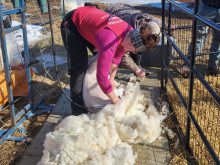BANFF, Alta. – The most common weeds in Western Canada have become the hardest to beat.
To date, 235 herbicide resistant species have been found in 45 countries. Thirty-two of them are in Canada, including wild mustard, hempnettle, chickweed, kochia, wild oats, cleavers and green foxtail.
The problem has been exacerbated among some species as they start showing multiple resistance. Manitoba was the first to report this situation. In some cases plants exhibit quadruple resistance.
In 1997, Manitoba reported 27 percent of wild mustard fields were showing multiple resistance.
Read Also

Charges laid after cattle theft
Saskatchewan RCMP lay two charges against a man after six cattle went missing.
“In Manitoba, they have recognized three different cross resistance patterns within a single field,” said Hugh Beckie of Agriculture Canada, during the expert committee on weeds meeting held in Banff Nov. 28.
In Saskatchewan, multiple resistance is showing up in wild oats.
“If you look at the field history, there is no evidence of heavy use of herbicides from a particular group to which the biotype exhibits resistance,” Beckie said.
“It is more likely due to enhanced metabolism than to actual multiple mechanisms of resistance.”
Plants like wild mustard have shown that a single, dominant nuclear gene provides resistance. Their metabolism may have altered as well so these plants can fend off herbicides more effectively.
The presence of cross resistance patterns within a field illustrates the difficulty in alternating different chemistries to combat weeds.
Resistance to group one herbicides is most prevalent in the West. Surveys show that most of the problem is in the Prairies’ parkland regions.
Group two pesticides, or ALS inhibitors, start to lose their effectiveness after seven applications.
ALS resistance has been found in eight species, including chickweed, Russian thistle, cleavers and hempnettle.
Additional group two problems have been found in kochia in southern Saskatchewan and Alberta.
In Ontario, several pigweed strains are showing different forms of resistance to these herbicides.
“The presence of different mutations in different populations suggest independent selection in geographically separated populations simultaneously,” Beckie said.
Group four herbicides have been used since the 1940s, but resistance was not a serious problem until the 1990s when wild mustard in Manitoba started to survive applications.
Scientists believe an alteration in the protein and amino acid sequencing is responsible for this latest problem.
There are six registered or soon-to-be registered herbicide resistant crops, including canola, flax, soybeans, wheat and corn.
“Growers should be dissuaded from repeat applications of glyphosate on a preceding grain crop.”
Beckie said this could increase the selection pressure for resistance among grass and broadleaf species, as well as troublesome volunteer cereals and oilseeds.
Some herbicides that are used alone or as mixtures should remove glyphosate resistant volunteers, but scientists have found some of these crops produce viable seeds for years.
Volunteer wheat was found four to five years after the last crop of Roundup Ready wheat was planted.
They can be controlled with group one herbicides.
The potential for outcrossing of these designer grains and oilseeds is possible, but does not produce viable hybrids.
Outcrossing was discovered in wild radish and dog mustard. The wild radish grew vigorously but was sterile.
The wild mustard could produce fertile seeds but the plants were weak.

















